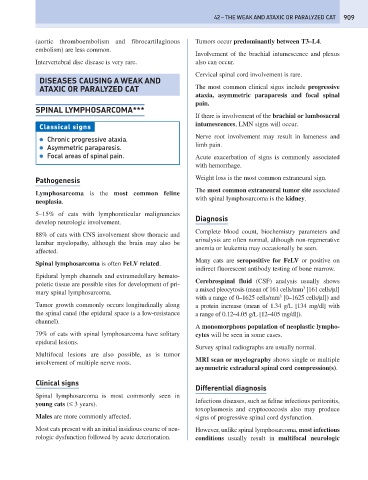Page 917 - Problem-Based Feline Medicine
P. 917
42 – THE WEAK AND ATAXIC OR PARALYZED CAT 909
(aortic thromboembolism and fibrocartilaginous Tumors occur predominantly between T3–L4.
embolism) are less common.
Involvement of the brachial intumescence and plexus
Intervertebral disc disease is very rare. also can occur.
Cervical spinal cord involvement is rare.
DISEASES CAUSING A WEAK AND
ATAXIC OR PARALYZED CAT The most common clinical signs include progressive
ataxia, asymmetric paraparesis and focal spinal
pain.
SPINAL LYMPHOSARCOMA***
If there is involvement of the brachial or lumbosacral
intumescences, LMN signs will occur.
Classical signs
● Chronic progressive ataxia. Nerve root involvement may result in lameness and
● Asymmetric paraparesis. limb pain.
● Focal areas of spinal pain. Acute exacerbation of signs is commonly associated
with hemorrhage.
Pathogenesis Weight loss is the most common extraneural sign.
The most common extraneural tumor site associated
Lymphosarcoma is the most common feline
with spinal lymphosarcoma is the kidney.
neoplasia.
5–15% of cats with lymphoreticular malignancies Diagnosis
develop neurologic involvement.
Complete blood count, biochemistry parameters and
88% of cats with CNS involvement show thoracic and
urinalysis are often normal, although non-regenerative
lumbar myelopathy, although the brain may also be
anemia or leukemia may occasionally be seen.
affected.
Many cats are seropositive for FeLV or positive on
Spinal lymphosarcoma is often FeLV related.
indirect fluorescent antibody testing of bone marrow.
Epidural lymph channels and extramedullary hemato-
Cerebrospinal fluid (CSF) analysis usually shows
poietic tissue are possible sites for development of pri-
3
a mixed pleocytosis (mean of 161 cells/mm [161 cells/μl]
mary spinal lymphosarcoma.
3
with a range of 0–1625 cells/mm [0–1625 cells/μl]) and
Tumor growth commonly occurs longitudinally along a protein increase (mean of 1.34 g/L [134 mg/dl] with
the spinal canal (the epidural space is a low-resistance a range of 0.12–4.05 g/L [12–405 mg/dl]).
channel).
A monomorphous population of neoplastic lympho-
79% of cats with spinal lymphosarcoma have solitary cytes will be seen in some cases.
epidural lesions.
Survey spinal radiographs are usually normal.
Multifocal lesions are also possible, as is tumor
MRI scan or myelography shows single or multiple
involvement of multiple nerve roots.
asymmetric extradural spinal cord compression(s).
Clinical signs
Differential diagnosis
Spinal lymphosarcoma is most commonly seen in
Infectious diseases, such as feline infectious peritonitis,
young cats (≤ 3 years).
toxoplasmosis and cryptococcosis also may produce
Males are more commonly affected. signs of progressive spinal cord dysfunction.
Most cats present with an initial insidious course of neu- However, unlike spinal lymphosarcoma, most infectious
rologic dysfunction followed by acute deterioration. conditions usually result in multifocal neurologic

